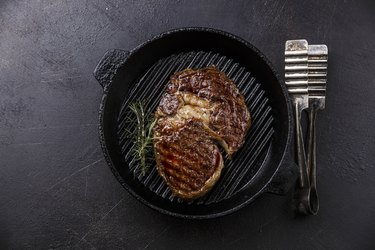
Like any other old, spoiled food, bad meat can make you sick. If the meat has been contaminated with something pathogenic, like bacteria or toxins, it can make you sick.
Tip
People who eat rancid meat are likely to get sick. Food-borne illness can occur after you’ve eaten bad meat that contains harmful microbes or toxins.
Video of the Day
Identifying Bad or Rancid Meat
Fresh meat usually has a mild smell or no smell at all. In comparison, rancid meat smells strange. You'll know if you have rancid meat in your fridge because it smells sour, sulfuric or like ammonia.
Video of the Day
As meat goes bad, it usually takes on grayish undertones. Bad meat is likely to have notable discolorations. Green and gray-green tints or spots are usually signs of bacterial growth.
The texture of your meat is also indicative of whether or not it's gone bad. Fresh meat should be firm and slightly moist. If your meat is slimy or sticky, your meat has likely become contaminated by some sort of microbe.
Not all microbes are dangerous. However, if your meat is contaminated with pathogenic bacteria such as salmonella, staphylococcus, clostridium or E. coli, you can become very sick from food poisoning. The Mayo Clinic says that food poisoning can cause symptoms such as abdominal pain, nausea, vomiting, fever, diarrhea and other gastrointestinal issues.
Cooking and eating spoiled pork, old chicken or any other bad meat isn't guaranteed to make you sick, though. Whether you'll get sick will also be determined by whether or not you fully cooked your food.
Many bacteria can be killed during the cooking process. For instance, if you've made a boiled stew or soup and cooked your meat for a while, you may not get sick.
However, heat isn't a guaranteed way to prevent food poisoning. This is because certain bacteria also release toxins, according to the Mayo Clinic. Even when you kill these bacteria by cooking them, their toxins will remain in the food and cause you to become sick.
Preventing Meat From Going Bad
According to the U. S. Food and Drug Administration, you should always keep meat and meat products in your refrigerator at 40 degrees Fahrenheit. This helps prevent spoilage. However, the duration of time meat can be kept at this temperature depends on the product. The FDA states that:
- Poultry can be kept in your refrigerator for two days.
- Ground meat, including sausages, can be kept in your refrigerator for two days.
- Hot dogs can be kept in the fridge for one to two weeks.
- Bacon can be kept in your refrigerator for 7 days.
- Steaks can be kept in your refrigerator for up to 5 days.
- Offal (organ meat) can be kept in your refrigerator for 2 to 5 days.
Meat that is left at 40 degrees F for longer than this amount of time will slowly start decomposing.
Freezing Meat and Meat Products
If you don't plan on eating your meat within the FDA-recommended time periods, you can keep your meat from going bad by freezing it at 0 degrees F. The USDA says that freezing food at this temperature inactivates bacteria and other microbes. Freezing food can even help destroy certain parasites.
The USDA says that food can technically be kept at zero degrees Fahrenheit indefinitely. However, your meat's quality will decline if it's kept in the freezer for too long. The FDA recommends the following limits:
- Poultry to be frozen for up to 12 months.
- Ground meat to be frozen for up to 4 months.
- Hot dogs to be frozen for up to2 months.
- Bacon to be frozen for up to 1 month.
- Steaks to be frozen for up to 12 months.
- Organ meat to be frozen for up to 4 months.
Whether it's fresh or frozen, meat needs to be cooked thoroughly to kill all bacteria that's present in it. The U.S. Department of Health and Human Services says you should cook most meats to an internal temperature of 145 degrees F. Poultry needs to be cooked to a slightly higher internal temperature of 165 degrees F.
Was this article helpful?
150 Characters Max
0/150
Thank you for sharing!
Thank you for your feedback!